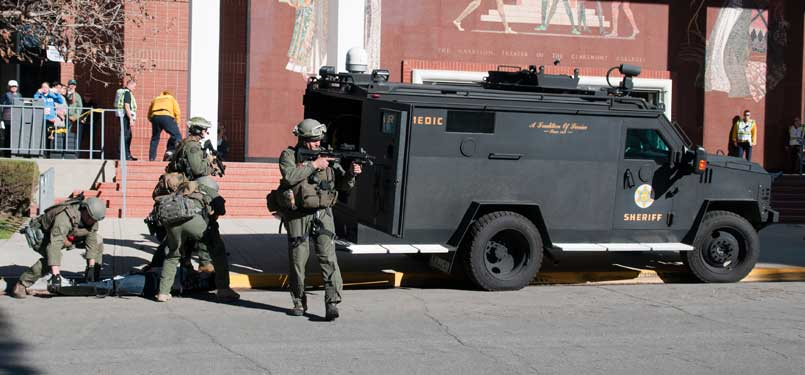DHS wants police departments to have armored tanks & armored ambulances, why not just give them M1 Abrams tanks and stop the lying?
Below are numerous disturbing stories of DHS giving police armored ambulances:
“It’s a tool, it’s not a weapon,” said Vacaville, Calif. Police Chief John Carli.
Carli described the vehicle as a “bullet-resistant people mover” to be used in high-risk situations.
He claimed the vehicle would not be used when dealing with protests or other demonstrations, as it is part of SWAT and not the Mobile Field Force that is responsible for protests.
If you're wondering what the Mobile Field Force is, below is an excerpt from their website:
"The NIPAS Mobile Field Force was created in the Spring of 1994 to maximized the effectiveness of initial response efforts by police when a major civil disturbance occurs. Civil disturbances, union conflicts, public demonstrations, and other events involving large or disorderly crowds require skillful response by police agencies."
Police across the country train with the DHS & the military learning how to quell protestors etc.
Click here, here & here to find out more.
Police are trained to use armored rescue vehicles against protestors and used them in Ferguson, MO.
A search for 'armored rescue vehicles on 'Police The Law Enforcement Magazine' looks like a special forces website.
Another search of law enforcement publications revealed two disturbing articles one titled 'Tactics For Police Armored Rescue Vehicles'. Try not to vomit as you read it. It's basically a military or DHS how-to-guide for using a tank, but I digress.
Here's an excerpt about the effectiveness of their use during what's called "Rowdy Crowd Control"
"ARVs are extremely effective in riot and rowdy crowd situations, offering officers protection from assault, thrown objects, and gunfire. Police in Europe have been using ARVs to quell riots for many years. However, unlike our European counterparts, American ARVs are not supported by water cannon trucks.
The psychological advantage of ARVs in crowd/riot situations cannot be underestimated. A good example is the tactical team that deployed its vehicle against a large crowd of rioters throwing rocks and bottles at police. The instant the ARV appeared, the rioters ran away. The vehicles are also a proven, effective counter-measure against snipers, one of the hallmarks of urban riots.
ARVs make excellent rolling chemical and less-lethal launching platforms. With almost no difficulty, they can also negotiate most obstacles rioters place in the way to obstruct police. In Germany, it is common for police ARVs to operate with clearing blades to remove manmade barriers such as downed trees, or flipped or flaming vehicles. A police ARV is often the vehicle of choice to spearhead a mobile field force convoy. Members of an entire mobile field force will become more confident because of the vehicle’s presence."
So its an effective use against snipers, good to know. But how many protests have had snipers shooting at police?
Anyone? NOT A GODDAMN ONE.
Armored ambulances are being used for "psychological advantage" to quell demonstrations across the country!
DHS run police departments are training their officers to use them like our military would.
The second article entitled 'Police Armored Vehicles: Tactical Rescues Considerations' reveals how police are using them like Spec-Ops soldiers would.
"In neighborhoods where respect for the law is thin and bad guys think that they can deal with any responding police, the appearance and intervention of a no-nonsense police armored rescue vehicle (ARV) can make them reconsider. Most law enforcement agencies have experienced incidents where bad guys surrender without further resistance when the ARV arrives. If part of the mission is medical evacuation of the wounded, sick, or injured, then the arrival of the vehicle has expedited the rescue and medical care.
A basic medical evacuation tactic is to position the ARV between the armed bad guy(s) and the wounded person(s). Then the wounded are loaded into the ARV. Buildings and terrain features can be utilized by the ARV’s driver to provide addition cover. In other situations ARVs can be used for observation, gaining entry into barricaded buildings, and protection of the team. Kevlar skirts can be placed onto hooks on the exterior of an ARV prior to deploying it into rescue situations. These skirts are optional ARV protective equipment rather than an integral part of ARV rescues; they hang to the ground to prevent ricochets.
Once the casualties are loaded into the ARV and a decision has been made for it to transport the casualties to a secured, soft skin ambulance or medical facility, law enforcement personnel should be given the word it is leaving. The reason? The arrival of an ARV is a law enforcement morale builder, and its departure can be a let down. The size of the ARV rescue crew will vary depending on the situation, and it is often accompanied by a rescue team on foot using the ARV as cover."
If you think America has turned into a battlefield you'd be right, its protestors & activists who've become the enemy. When was the last time a protestor used a high-powered AP or HE round that could penetrate these so-called ambulances" in the U.S.?
NEVER, It's all a lie.
West Bloomfield Police Chief Michael Patton said that a number of vehicles were deployed to the scene and were used to either protect the lives of the police and fire responders, or to rescue residents who were hiding in their homes in the neighborhood.
“People always sit back and refer to it as a tank. It’s not a tank; it doesn’t shoot anything,” Patton said. “There is a lot of misunderstanding as to why agencies would want something like this. … From an occupational safety standpoint, we’re obligated to provide protective measures to our staff.”
Does this look like a rescue vehicles to you?
The vehicle, called "Rescue One," would serve as an armored rescue vehicle, Horn County Police Chief Saundra Rhodes said. It can accommodate 10 tactical officers during transportation operations; cross rivers with a depth of 3 feet; drive over large obstacles and debris; and enable rescue from rooftops, according to the agency.
Horry County, South Carolina police unveiled Rescue 1 on Monday, the department’s first armored Caiman vehicle that will be available for rescues and hazardous transportation.
The 60,728 pound vehicle is a military surplus vehicle that came from Sealy, Texas and was obtained through a federal program administered by the S.C. Budget and Control Board, Horry County police Chief Saundra Rhodes said Monday.
Click here to find out more about Lenco's Bearcat Medevac tactical vehicles.



 "We (government) need to do a lot less, a lot sooner" ~Ron Paul
"We (government) need to do a lot less, a lot sooner" ~Ron Paul
